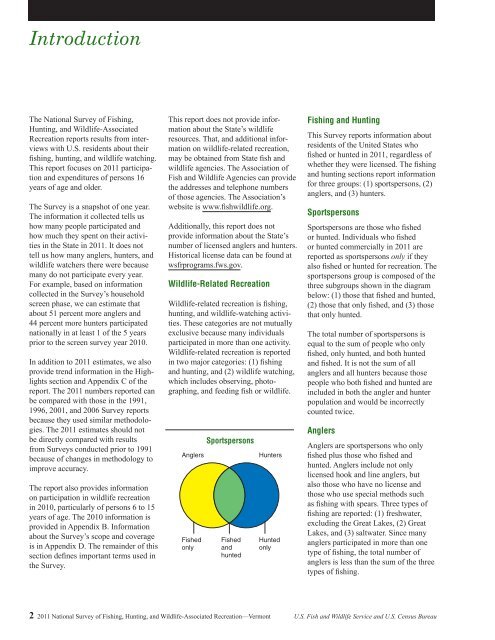2011 National Survey of Fishing, Hunting, and ... - Census Bureau
2011 National Survey of Fishing, Hunting, and ... - Census Bureau
2011 National Survey of Fishing, Hunting, and ... - Census Bureau
You also want an ePaper? Increase the reach of your titles
YUMPU automatically turns print PDFs into web optimized ePapers that Google loves.
Introduction<br />
The <strong>National</strong> <strong>Survey</strong> <strong>of</strong> <strong>Fishing</strong>,<br />
<strong>Hunting</strong>, <strong>and</strong> Wildlife-Associated<br />
Recreation reports results from interviews<br />
with U.S. residents about their<br />
fishing, hunting, <strong>and</strong> wildlife watching.<br />
This report focuses on <strong>2011</strong> participation<br />
<strong>and</strong> expenditures <strong>of</strong> persons 16<br />
years <strong>of</strong> age <strong>and</strong> older.<br />
The <strong>Survey</strong> is a snapshot <strong>of</strong> one year.<br />
The information it collected tells us<br />
how many people participated <strong>and</strong><br />
how much they spent on their activities<br />
in the State in <strong>2011</strong>. It does not<br />
tell us how many anglers, hunters, <strong>and</strong><br />
wildlife watchers there were because<br />
many do not participate every year.<br />
For example, based on information<br />
collected in the <strong>Survey</strong>’s household<br />
screen phase, we can estimate that<br />
about 51 percent more anglers <strong>and</strong><br />
44 percent more hunters participated<br />
nationally in at least 1 <strong>of</strong> the 5 years<br />
prior to the screen survey year 2010.<br />
In addition to <strong>2011</strong> estimates, we also<br />
provide trend information in the Highlights<br />
section <strong>and</strong> Appendix C <strong>of</strong> the<br />
report. The <strong>2011</strong> numbers reported can<br />
be compared with those in the 1991,<br />
1996, 2001, <strong>and</strong> 2006 <strong>Survey</strong> reports<br />
because they used similar methodologies.<br />
The <strong>2011</strong> estimates should not<br />
be directly compared with results<br />
from <strong>Survey</strong>s conducted prior to 1991<br />
because <strong>of</strong> changes in methodology to<br />
improve accuracy.<br />
The report also provides information<br />
on participation in wildlife recreation<br />
in 2010, particularly <strong>of</strong> persons 6 to 15<br />
years <strong>of</strong> age. The 2010 information is<br />
provided in Appendix B. Information<br />
about the <strong>Survey</strong>’s scope <strong>and</strong> coverage<br />
is in Appendix D. The remainder <strong>of</strong> this<br />
section defines important terms used in<br />
the <strong>Survey</strong>.<br />
This report does not provide information<br />
about the State’s wildlife<br />
resources. That, <strong>and</strong> additional information<br />
on wildlife-related recreation,<br />
may be obtained from State fish <strong>and</strong><br />
wildlife agencies. The Association <strong>of</strong><br />
Fish <strong>and</strong> Wildlife Agencies can provide<br />
the addresses <strong>and</strong> telephone numbers<br />
<strong>of</strong> those agencies. The Association’s<br />
website is www.fishwildlife.org.<br />
Additionally, this report does not<br />
provide information about the State’s<br />
number <strong>of</strong> licensed anglers <strong>and</strong> hunters.<br />
Historical license data can be found at<br />
wsfrprograms.fws.gov.<br />
Wildlife-Related Recreation<br />
Wildlife-related recreation is fishing,<br />
hunting, <strong>and</strong> wildlife-watching activities.<br />
These categories are not mutually<br />
exclusive because many individuals<br />
participated in more than one activity.<br />
Wildlife-related recreation is reported<br />
in two major categories: (1) fishing<br />
<strong>and</strong> hunting, <strong>and</strong> (2) wildlife watching,<br />
which includes observing, photographing,<br />
<strong>and</strong> feeding fish or wildlife.<br />
Anglers<br />
Fished<br />
only<br />
Sportspersons<br />
Fished<br />
<strong>and</strong><br />
hunted<br />
Hunters<br />
Hunted<br />
only<br />
<strong>Fishing</strong> <strong>and</strong> <strong>Hunting</strong><br />
This <strong>Survey</strong> reports information about<br />
residents <strong>of</strong> the United States who<br />
fished or hunted in <strong>2011</strong>, regardless <strong>of</strong><br />
whether they were licensed. The fishing<br />
<strong>and</strong> hunting sections report information<br />
for three groups: (1) sportspersons, (2)<br />
anglers, <strong>and</strong> (3) hunters.<br />
Sportspersons<br />
Sportspersons are those who fished<br />
or hunted. Individuals who fished<br />
or hunted commercially in <strong>2011</strong> are<br />
reported as sportspersons only if they<br />
also fished or hunted for recreation. The<br />
sportspersons group is composed <strong>of</strong> the<br />
three subgroups shown in the diagram<br />
below: (1) those that fished <strong>and</strong> hunted,<br />
(2) those that only fished, <strong>and</strong> (3) those<br />
that only hunted.<br />
The total number <strong>of</strong> sportspersons is<br />
equal to the sum <strong>of</strong> people who only<br />
fished, only hunted, <strong>and</strong> both hunted<br />
<strong>and</strong> fished. It is not the sum <strong>of</strong> all<br />
anglers <strong>and</strong> all hunters because those<br />
people who both fished <strong>and</strong> hunted are<br />
included in both the angler <strong>and</strong> hunter<br />
population <strong>and</strong> would be incorrectly<br />
counted twice.<br />
Anglers<br />
Anglers are sportspersons who only<br />
fished plus those who fished <strong>and</strong><br />
hunted. Anglers include not only<br />
licensed hook <strong>and</strong> line anglers, but<br />
also those who have no license <strong>and</strong><br />
those who use special methods such<br />
as fishing with spears. Three types <strong>of</strong><br />
fishing are reported: (1) freshwater,<br />
excluding the Great Lakes, (2) Great<br />
Lakes, <strong>and</strong> (3) saltwater. Since many<br />
anglers participated in more than one<br />
type <strong>of</strong> fishing, the total number <strong>of</strong><br />
anglers is less than the sum <strong>of</strong> the three<br />
types <strong>of</strong> fishing.<br />
2 <strong>2011</strong> <strong>National</strong> <strong>Survey</strong> <strong>of</strong> <strong>Fishing</strong>, <strong>Hunting</strong>, <strong>and</strong> Wildlife-Associated Recreation—Vermont U.S. Fish <strong>and</strong> Wildlife Service <strong>and</strong> U.S. <strong>Census</strong> <strong>Bureau</strong>
















